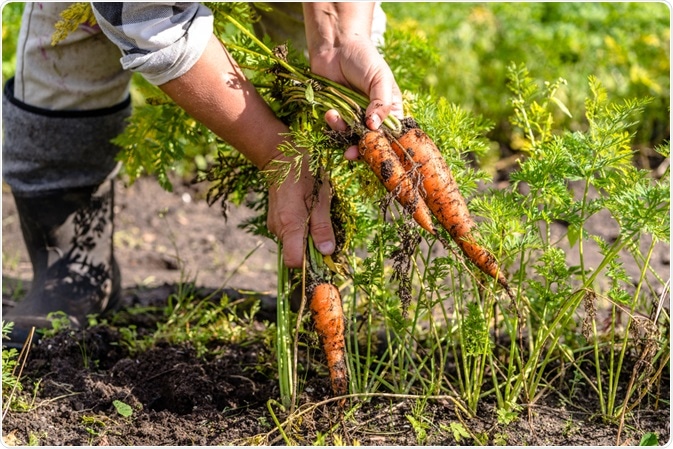Food insecurity is a significant global issue that has increased over recent years. Statistics from the UN have revealed that roughly 720-811 million people went hungry in 2020, with this number expected to have risen in 2021 partially due to the COVID-19 pandemic.

Image Credit: alicja neumiler/Shutterstock.com
Growing populations and areas that are undergoing rapid urbanization are those that are most at risk of food insecurity. As populations increase, as does the competition for agricultural space due to the rising use of land for homes and infrastructure. This is having the impact of pushing up the prices of essential food items, making it harder for low-to-middle-income families to afford sufficient nutrition.
Scientists have been working on innovating ways to combat food insecurity. Inventions such as vertical farming, technology that can reduce food waste such as edible sensors, and community-based systems that encourage the sharing of food that would go to waste are some of the most encouraging strategies. Additionally, innovations that focus on boosting crop yields by adjusting soil conditions have also emerged as important strategies that could be significant in reversing food insecurity.
Reversing the effects of soil erosion
Soil is vital to a successful crop yield, it anchors the plants, provides them with nutrients, holds reserves of water, and also plays a role in moderating the temperature directly surrounding the plants and their roots. All these factors can impact crop growth and ultimately crop yield.
Soil erosion acts as a major threat to securing soil of an appropriate quality to provide plants with the sustenance they require. Over the years, research has elucidated a strong connection between soil erosion and crop yields.
Each year around 10 million hectares of agricultural land is abandoned after it fails to produce a sufficient crop yield due to soil erosion. This data emphasizes the significant detrimental of soil erosion on food production. It also highlights the potential value of implementing efforts to reverse soil erosion.
Deforestation and climate change are considered the greatest factors contributing to soil erosion. Therefore, initiating projects that protect forests and reverse the effects of climate change are vital to preventing soil erosion and increasing food production.
Additionally, while both organic and traditional agricultural practices can contribute to soil erosion, organic methods are much more weakly associated. Switching to organic practices is one solution to slowing down soil erosion that is estimated to be affecting 80% of the world’s agricultural land.
How the microbiome of soil can enhance crop yields
Microbial-based agricultural solutions are rapidly growing in popularity. These solutions are solving some of the industry’s most urgent issues, including providing a method of enhancing crop yields. Research shows that microbes in the soil play an important role in plant growth. Therefore, manipulating the levels of certain microbial populations can influence plant growth. Many studies are being carried out to learn more about how the soil microbiome can be amended to have the greatest benefit on plant growth.
The results of these studies have already revealed that microbial populations can be influenced to enhance plant growth, make plants more resistant to threats such as pests, droughts, and extreme weather, all factors which can improve crop yields.
Scientists have begun to leverage this research to develop microbial-based solutions that capitalize on the natural activity of microbes to increase crop yields and plant quality. These solutions work by analyzing soil samples to identify the microbes that make up the soil microbiome. This information then informs scientists on how this balance of microbes can be amended to achieve the greatest benefit for crop yields.
Evidence shows that crop yields can be enhanced by around 15% via the use of microbial-based solutions. With the widespread, global adoption of microbial-based solutions, more food could be produced each year using the same size of agricultural land.
Leveraging the IoT to boost soil features
Finally, the Internet of Things (IoT) is also being leveraged by the agricultural sector to enhance numerous factors, including crop yields. Sensors connected wirelessly to the internet can communicate a wealth of data points in real-time.
Scientists have developed sensors specifically designed to measure different factors that affect the soil. These sensors transmit data to internet-connected software systems that can automatically trigger actions that adjust soil conditions to maintain an optimum environment for the crops to grow. For example, sensors can measure levels of moisture in the soil, when it becomes too low, sprinklers can be triggered automatically.
Scientists will likely continue to develop systems that can enhance crop yields by influencing the soil. Crop yields will continue to be vitally important in the fight to achieve global food security, and the soil offers a great opportunity to boost crop production by enhancing the natural interaction between the soil and crops.
Sources:
- Food Security and COVID-19. The World Bank. Available at: www.worldbank.org/.../food-security-and-covid-19
- Lal, R. and Moldenhauer, W., 1987. Effects of soil erosion on crop productivity. Critical Reviews in Plant Sciences, 5(4), pp.303-367. https://doi.org/10.1080/07352688709382244
- Reganold, J., Elliott, L. and Unger, Y., 1987. Long-term effects of organic and conventional farming on soil erosion. Nature, 330(6146), pp.370-372. https://www.nature.com/articles/330370a0
- Schlundt, J., Tay, M., Chengcheng, H. and Liwei, C., 2020. Food Security: Microbiological and Chemical Risks. Advanced Sciences and Technologies for Security Applications, pp.231-274. https://link.springer.com/chapter/10.1007/978-3-030-23491-1_11
Further Reading